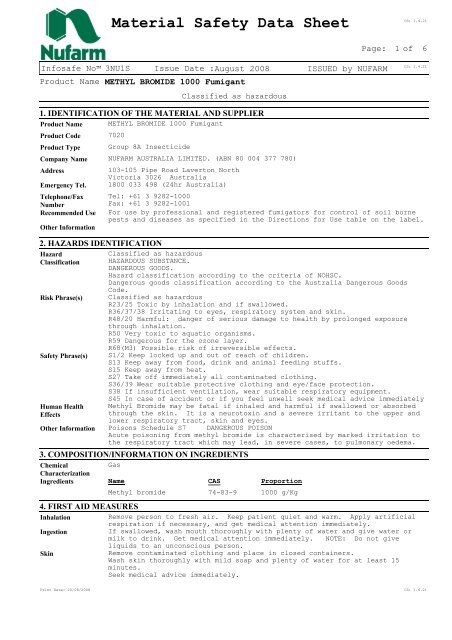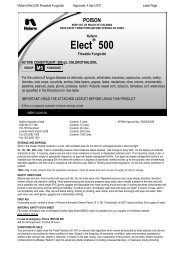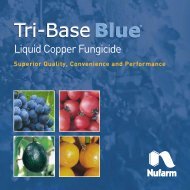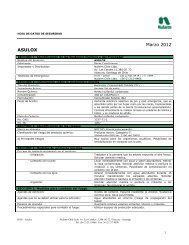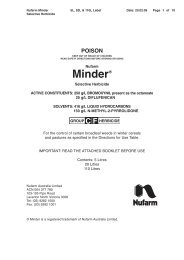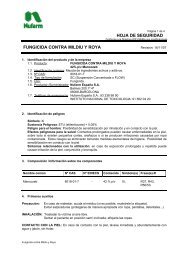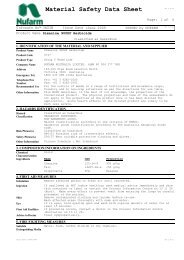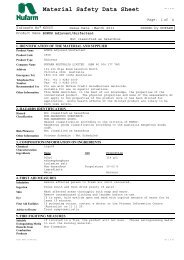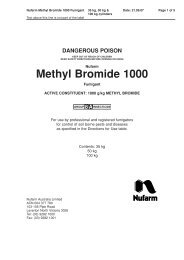MSDS - Nufarm
MSDS - Nufarm
MSDS - Nufarm
Create successful ePaper yourself
Turn your PDF publications into a flip-book with our unique Google optimized e-Paper software.
Material Safety Data Sheet<br />
CS: 1.4.21<br />
Page: 1<br />
of<br />
6<br />
CS: 1.4.21<br />
Infosafe No 3NU1S Issue Date : August 2008 ISSUED by NUFARM<br />
Product Name METHYL BROMIDE 1000 Fumigant<br />
Classified as hazardous<br />
1. IDENTIFICATION OF THE MATERIAL AND SUPPLIER<br />
Product Name METHYL BROMIDE 1000 Fumigant<br />
Product Code 7020<br />
Product Type Group 8A Insecticide<br />
Company Name NUFARM AUSTRALIA LIMITED. (ABN 80 004 377 780)<br />
Address<br />
103-105 Pipe Road Laverton North<br />
Victoria 3026 Australia<br />
Emergency Tel. 1800 033 498 (24hr Australia)<br />
Telephone/Fax<br />
Number<br />
Tel: +61 3 9282-1000<br />
Fax: +61 3 9282-1001<br />
Recommended Use For use by professional and registered fumigators for control of soil borne<br />
pests and diseases as specified in the Directions for Use table on the label.<br />
Other Information<br />
2. HAZARDS IDENTIFICATION<br />
Hazard<br />
Classification<br />
Risk Phrase(s)<br />
Safety Phrase(s)<br />
Human Health<br />
Effects<br />
Classified as hazardous<br />
HAZARDOUS SUBSTANCE.<br />
DANGEROUS GOODS.<br />
Hazard classification according to the criteria of NOHSC.<br />
Dangerous goods classification according to the Australia Dangerous Goods<br />
Code.<br />
Classified as hazardous<br />
R23/25 Toxic by inhalation and if swallowed.<br />
R36/37/38 Irritating to eyes, respiratory system and skin.<br />
R48/20 Harmful: danger of serious damage to health by prolonged exposure<br />
through inhalation.<br />
R50 Very toxic to aquatic organisms.<br />
R59 Dangerous for the ozone layer.<br />
R68(M3) Possible risk of irreversible effects.<br />
S1/2 Keep locked up and out of reach of children.<br />
S13 Keep away from food, drink and animal feeding stuffs.<br />
S15 Keep away from heat.<br />
S27 Take off immediately all contaminated clothing.<br />
S36/39 Wear suitable protective clothing and eye/face protection.<br />
S38 If insufficient ventilation, wear suitable respiratory equipment.<br />
S45 In case of accident or if you feel unwell seek medical advice immediately<br />
Methyl Bromide may be fatal if inhaled and harmful if swallowed or absorbed<br />
through the skin. It is a neurotoxin and a severe irritant to the upper and<br />
lower respiratory tract, skin and eyes.<br />
Other Information Poisons Schedule S7 DANGEROUS POISON<br />
Acute poisoning from methyl bromide is characterised by marked irritation to<br />
the respiratory tract which may lead, in severe cases, to pulmonary oedema.<br />
3. COMPOSITION/INFORMATION ON INGREDIENTS<br />
Chemical<br />
Gas<br />
Characterization<br />
Ingredients<br />
Name<br />
CAS<br />
Methyl bromide<br />
74-83-9<br />
Proportion<br />
1000 g/Kg<br />
4. FIRST AID MEASURES<br />
Inhalation<br />
Remove person to fresh air. Keep patient quiet and warm. Apply artificial<br />
respiration if necessary, and get medical attention immediately.<br />
Ingestion<br />
If swallowed, wash mouth thoroughly with plenty of water and give water or<br />
milk to drink. Get medical attention immediately. NOTE: Do not give<br />
liquids to an unconscious person.<br />
Skin<br />
Remove contaminated clothing and place in closed containers.<br />
Wash skin thoroughly with mild soap and plenty of water for at least 15<br />
minutes.<br />
Seek medical advice immediately.<br />
Print Date: 20/08/2008 CS: 1.4.21
Material Safety Data Sheet<br />
CS: 1.4.21<br />
Page: 2<br />
of<br />
6<br />
CS: 1.4.21<br />
Infosafe No 3NU1S Issue Date : August 2008 ISSUED by NUFARM<br />
Product Name METHYL BROMIDE 1000 Fumigant<br />
Eye<br />
First Aid Facilities<br />
Advice to Doctor<br />
First Aid<br />
Classified as hazardous<br />
All leather items should be discarded; other contaminated clothing must be<br />
discarded or thoroughly ventilated and washed before re-use.<br />
If in eyes, hold the eyelids apart, flush at once with copious flowing water<br />
for at least 15 minutes. Seek medical attention immediately.<br />
If poisoning occurs, contact a doctor or the Poisons Information Centre<br />
(Australia) on 13 11 26.<br />
Treat symptomatically.<br />
Intense vesicant. Signs and symptoms of toxicity are primarily referrable to<br />
the CNS, respiratory tract and the cardiovascular system.<br />
No specific antidote.<br />
Give artificial respiration if necessary but oxygen or stimulants only under<br />
qualified supervision. Human systemic effects by inhalation: anorexia,<br />
nausea or vomiting. A powerful fumigant gas which is one of the most toxic of<br />
the common organic halides. It is nematoxic and narcotic with delayed action,<br />
it is cumulative and damaging to nervous system, kidneys, lungs.<br />
Delayed effects can include pulmonary oedema.<br />
A 24-HOUR MEDICAL SURVEILLANCE PERIOD IS MANDATORY IN ALL CASES OF EXPOSURE TO<br />
METHYL BROMIDE, EVEN IN THE ABSENCE OF ANY IMMEDIATE SIGNS OF POISONING.<br />
5. FIRE FIGHTING MEASURES<br />
Specific Hazards Although the product is considered practically non flammable, it can be<br />
ignited with a high energy source of ignition. Containers may rupture<br />
violently if exposed to fire or excessive heat for sufficient time. In<br />
confined spaces such as buildings or sewers, there is a danger of vapour<br />
accumulation, which may result in explosion in the presence of an ignition<br />
source.<br />
If product involved in a fire, stop methyl bromide flow immediately. Do not<br />
extinguish burning gas unless flow can be shut off immediately. Use water<br />
spray, fog nozzle or CO2 to keep cylinder cool. If there is no risk, move<br />
cylinder away from fire. Use self-contained breathing apparatus with a full<br />
face-piece operating in positive pressure mode, and appropriate protective<br />
clothing.<br />
Extinguishing media: Water spray or fog, dry chemical foam and carbon<br />
dioxide.<br />
Hazchem Code 2 X E<br />
Decomposition<br />
Temp.<br />
Decomposes from ca. 400°C<br />
When heated to decomposition, may release poisonous and corrosive fumes of CO<br />
and HBr.<br />
6. ACCIDENTAL RELEASE MEASURES<br />
Spills & Disposal Evacuate area and keep personnel upwind. Use self-contained breathing<br />
apparatus in positive-pressure mode. If practicable, stop flow of vapour.<br />
Shut off all sources of ignition. Ventilate and/or allow to evaporate,<br />
keeping people away from area until safe re-entry levels are shown by an<br />
appropriate measuring device.<br />
7. HANDLING AND STORAGE<br />
Precautions for Safe WARNING: Methyl Bromide gas is colourless, odourless and highly dangerous.<br />
Handling<br />
Extreme caution is required when handling.<br />
Conditions for Safe Store in a well ventilated place.<br />
Storage<br />
Do not store for prolonged periods in direct sunlight.<br />
The above statement is mandated by the APVMA, and is required to appear on<br />
almost all labels of agricultural chemicals. The original manufacturer<br />
recommends that methyl bromide cylinders not be stored in enclosed spaces.<br />
Storage in open spaces is strongly recommended. The original manufacturer<br />
does not warn against storage in direct sunlight.<br />
DO NOT drop, bump or drag cylinders. Do NOT dent cans.<br />
DO NOT unload by rope-sling, hooks or tongs.<br />
Keep cylinders upright in tamper-proof airy stores, away from dwellings and<br />
food and feed stuffs.<br />
Test periodically for leaks by halide leak detector.<br />
DO NOT spill or splash; avoid contact with the liquid or gas.<br />
Put out all pilot lights and glowing heating units.<br />
Print Date: 20/08/2008 CS: 1.4.21
Material Safety Data Sheet<br />
CS: 1.4.21<br />
Page: 3<br />
of<br />
6<br />
CS: 1.4.21<br />
Infosafe No 3NU1S Issue Date : August 2008 ISSUED by NUFARM<br />
Product Name METHYL BROMIDE 1000 Fumigant<br />
Classified as hazardous<br />
8. EXPOSURE CONTROLS/PERSONAL PROTECTION<br />
National Exposure<br />
Standards<br />
NOHSC has set the following exposure standard for methyl bromide : TLV (TWA) 5<br />
ppm 19 mg/m3, STEL -. SK<br />
'SK' notice - absorption through the skin may be a significant source of<br />
exposure. The exposure standard is invalidated if such contact should occur.<br />
Threshold limit value:<br />
Methyl bromide:<br />
USA<br />
OSHA STEL:C 20ppm (C 80mg/m3), skin<br />
ACGIH TWA: 1ppm (3.9mg/m3), skin<br />
UK TWA: 5ppm (20mg/m3)<br />
STEL: 15ppm (59mg/m3), 10 min<br />
Engineering Ventilation must be sufficient to maintain methyl bromide level below the TLV.<br />
Controls<br />
Mechanical ventilation is recommended. Use local exhaust at source of vapour.<br />
Hand Protection DO NOT WEAR GLOVES when working with Methyl bromide because of the danger that<br />
liquid or concentrated vapour may be trapped inside them. DO NOT wear rings<br />
or watches, especially watches with a leather band.<br />
Personal Protective Very dangerous. Product is poisonous if inhaled. Attacks eyes. May irritate<br />
Equipment<br />
the nose, throat and skin. Repeated minor exposure may have a cumulative<br />
poisoning effect. The liquid can cause burns. Avoid contact with eyes, skin<br />
and clothing. Do not inhale vapour. Protect eyes while using. When using<br />
the product wear full-facepiece respirator with canister specified for Methyl<br />
Bromide. Detailed instructions for safe use appear in State regulations.<br />
Thoroughly ventilate treated areas before re-occupying.<br />
If clothing becomes contaminated with product, remove clothing immediately.<br />
After use, and before eating, drinking or smoking wash hands, arms and face<br />
thoroughly with soap and water. After each day's use, wash respirator and<br />
face piece. If respirator is rubber wash with detergent and warm water.<br />
General Fumigation: Wear full-face respirator (with Methyl Bromide 'O'<br />
canister) complying with AS1716 when releasing gas and when opening up<br />
structures for aeration. Use a halide detector for locating gas leaks from<br />
cylinders and outside structures. Use detection tubes or other monitoring<br />
devices inside structures.<br />
The above canister masks are suitable for low levels of methyl bromide. If<br />
high levels of methyl bromide gas are expected, it is advisable to wear self<br />
contained breathing apparatus with a mask in positive pressure mode.<br />
DO NOT enter fumigation areas until methyl bromide free as indicated by<br />
appropriate measuring devices. If however treated area must be entered, a<br />
self-contained breathing suit or apparatus conforming to AS1715 and AS1716<br />
MUST BE WORN.<br />
Body Protection No specially designed protective clothing is available.<br />
Do not wear gloves, impervious boots, finger rings or adhesive bandages on<br />
hands when handling this material.<br />
9. PHYSICAL AND CHEMICAL PROPERTIES<br />
Form<br />
Gas<br />
Appearance Colourless gas, with a sharp, penetrating odour.<br />
Clear, colourless to straw-coloured liquid under pressure or below ca. 3.5°C.<br />
Decomposition Decomposes from ca. 400°C<br />
Temperature When heated to decomposition, may release poisonous and corrosive fumes of CO<br />
and HBr.<br />
Boiling Point 3.5 - 4°C<br />
Solubility in Organic Infinitely soluble in most organic solvents<br />
Solvents<br />
Specific Gravity 1.73 (liquid)<br />
Vapour Pressure 1420mm Hg at 20°C<br />
Vapour Density 3.3 at 20°C<br />
(Air=1)<br />
Evaporation Rate >1<br />
Print Date: 20/08/2008 CS: 1.4.21
Material Safety Data Sheet<br />
CS: 1.4.21<br />
Page: 4<br />
of<br />
6<br />
CS: 1.4.21<br />
Infosafe No 3NU1S Issue Date : August 2008 ISSUED by NUFARM<br />
Product Name METHYL BROMIDE 1000 Fumigant<br />
Classified as hazardous<br />
Octanol/Water Log 10 Kow - ca. 1.92<br />
Partition Coefficient<br />
Flash Point<br />
None<br />
Flammability Non flammable, can be ignited with a high energy source.<br />
Auto-Ignition 537°C<br />
Temperature<br />
Flammable Limits - Lower 10 (vol); Upper 16 (vol)<br />
Lower<br />
Molecular Weight 94.94<br />
10. STABILITY AND REACTIVITY<br />
Chemical Stability Stable in sealed containers and under normal conditions.<br />
Conditions to Avoid Ignition sources, water contamination and heating above 400°C.<br />
Hazardous<br />
Hydrogen bromide and carbon monoxide.<br />
Decomposition<br />
Products<br />
Hazardous Reactions Incompatibility: Strong oxidizers, aluminium and magnesium metals and their<br />
alloys, natural rubber and certain types of plastic.<br />
Hazardous<br />
Hazardous polymerisation is not possible.<br />
Polymerization<br />
11. TOXICOLOGICAL INFORMATION<br />
Inhalation<br />
Acute poisoning from methyl bromide is characterized by marked irritation to<br />
the respiratory tract which may lead, in severe cases, to pulmonary oedema.<br />
High concentrations may damage the liver, kidneys and central nervous system.<br />
Symptoms of poisoning include headache, dizziness, somnolence, vertigo,<br />
blurred vision, slurred speech, nausea and vomiting and possibly convulsions<br />
and coma.<br />
ONSET OF TOXIC SYMPTOMS MAY BE DELAYED FROM 30 MINUTES TO SEVERAL DAYS.<br />
Ingestion<br />
Severe irritant to mucous membranes and extremely toxic poison if ingested,<br />
although ingestion is highly unlikely.<br />
Skin<br />
Liquid splashed on clothing or leather and/or high gas concentrations held in<br />
contact with skin, may cause skin burns with large blisters appearing after<br />
several hours. Less severe exposure may cause itching skin rash after several<br />
days. May be absorbed through the skin in sufficient quantities to cause<br />
systemic toxicity.<br />
Eye<br />
Severe irritant. Contact of liquid or high concentrations of gas with the<br />
eyes may cause severe but usually reversible injury involving temporary<br />
blindness.<br />
Chronic Effects Chronic exposure to low concentrations of methyl bromide may produce central<br />
nervous system effects. Signs include: mental confusion, lethargy, inability<br />
to focus one's eyes, inco-ordination and muscle weakness. Repeated skin<br />
exposure may cause contact dermatitis.<br />
Mutagenicity Mutagenic by the Ames Test.<br />
Methyl bromide induced DNA damage in rat testes is following inhalation<br />
exposure at 250ppm (6 hours/day for 5 consecutive days). In vivo, Methyl<br />
bromide induced sister chromatid exchanges in bone marrow cells and<br />
micronuclei in peripheral erythrocytes of female mice exposed by inhalation<br />
for 14 days.<br />
Carcinogenicity Studies conducted with Methyl bromide, exposing animals both by inhalation<br />
(rats & mice) and by oral route (fumigated feed, rats), showed that there was<br />
no evidence of carcinogenic activity.<br />
Not included in NTP 9th Report on Carcinogens.<br />
Acute Toxicity - Oral LD50 (rat) 104 mg/kg for liquid methyl bromide in corn oil<br />
LD50 (rat) 133 mg/kg for microencapsulated methyl bromide in corn oil<br />
Acute Toxicity - LC50 (inhalation, mouse) - 1540mg/m3/2hr<br />
Inhalation<br />
LC50 (inhalation, rat ) - 1175mg/m3/8hr<br />
Other Information The Australian Acceptable Daily Intake (ADI) for methyl bromide for a human is<br />
0.0004 mg/kg/day, set for the public for daily, lifetime exposure. This is<br />
based on the NOEL of 0.4 mg/kg/day, the level determined to show no effects<br />
during long term exposure for the most sensitive indicators and the most<br />
Print Date: 20/08/2008 CS: 1.4.21
Material Safety Data Sheet<br />
CS: 1.4.21<br />
Page: 5<br />
of<br />
6<br />
CS: 1.4.21<br />
Infosafe No 3NU1S Issue Date : August 2008 ISSUED by NUFARM<br />
Product Name METHYL BROMIDE 1000 Fumigant<br />
Classified as hazardous<br />
sensitive species. (Ref: Comm. Dept. of Health and Ageing Office of Chemical<br />
Safety, 'ADI List', September 2007).<br />
Single exposure vapour inhalation neurotoxicity study in rats: NOEL 100ppm<br />
Acute oral toxicity (single dose) study in Beagle dogs:<br />
Lethal dose 500mg/kg; No clinical signs were observed at 1 mg/kg.<br />
12. ECOLOGICAL INFORMATION<br />
Ecotoxicity<br />
Methyl bromide is listed in the Montreal Protocol as a controlled substance<br />
with an ODP (Ozone Depleting Potential) of 0.6.<br />
Environ. Protection DO NOT fumigate more than once as commodity is likely to become unfit for use.<br />
DO NOT treat within 50cm of desirable vegetation. Do NOT apply to areas<br />
adjacent to valuable crops.<br />
Signs as below must be prominently shown in all approaches to fumigation site.<br />
'DANGER - TOXIC GAS - KEEP AWAY'<br />
Station a guard at the treatment site to prevent entry of unauthorised<br />
persons, children and animals, during treatment and aeration period. After<br />
fumigation, aerate structures well, until an appropriate measuring device<br />
indicates fumigation area free of methyl bromide.<br />
Acute Toxicity - Fish LC50 (96hr) for rainbow trout is 3.9 mg/l.<br />
LC50 (96hr) for zebrafish is 56 mg/l.<br />
Acute Toxicity - EC50 (48 hrs): 2.6 mg/l<br />
Daphnia<br />
Acute Toxicity - EC50 (72 hrs) for selenastrum capricornutum 5 mg/l.<br />
Algae<br />
Acute Toxicity - LD50 for northern bobwhite is ca.73 mg/kg<br />
Other Organisms<br />
13. DISPOSAL CONSIDERATIONS<br />
Waste Disposal Observe all federal, state or local environmental regulations when disposing<br />
of this material. The recommended method of waste disposal is incineration.<br />
If a suitable designated combustion chamber is not available, return MARKED<br />
containers to supplier.<br />
14. TRANSPORT INFORMATION<br />
U.N. Number 1062<br />
Proper Shipping METHYL BROMIDE<br />
Name<br />
DG Class 2.3<br />
Sub.Risk -<br />
Hazchem Code 2 X E<br />
Packaging Method 3.8.2RT2<br />
Packing Group N/A<br />
Storage and<br />
Transport<br />
Considered dangerous for transport by the Australian Code for the Transport of<br />
Dangerous Goods by Road and Rail.<br />
EPG Number 2B1<br />
IERG Number 07<br />
UN Number (Air<br />
Transport, ICAO)<br />
Cargo Aircraft - Forbidden<br />
Passenger Aircraft - Forbidden<br />
15. REGULATORY INFORMATION<br />
Poisons Schedule S7<br />
Packaging &<br />
Labelling<br />
Hazard Category<br />
AICS (Australia)<br />
DANGEROUS POISON<br />
KEEP OUT OF REACH OF CHILDREN<br />
READ SAFETY DIRECTIONS BEFORE OPENING OR USING<br />
Toxic,Irritant,Dangerous for the environment<br />
All of the components in this product are listed on the Australian Inventory<br />
of Chemical Substances.<br />
Print Date: 20/08/2008 CS: 1.4.21
Material Safety Data Sheet<br />
CS: 1.4.21<br />
Page: 6<br />
of<br />
6<br />
CS: 1.4.21<br />
Infosafe No 3NU1S Issue Date : August 2008 ISSUED by NUFARM<br />
Product Name METHYL BROMIDE 1000 Fumigant<br />
Classified as hazardous<br />
16. OTHER INFORMATION<br />
Date of preparation 20/08/2008<br />
or last revision of<br />
<strong>MSDS</strong><br />
Contact<br />
Normal Hours: Mr Volker Maier Phone: (03) 9282 1000<br />
Person/Point After Hours: Shift Supervisor Phone: 1800 033 498<br />
Revisions<br />
The <strong>MSDS</strong> was reviewed. Minor changes were made to the information.<br />
Highlighted<br />
...End Of <strong>MSDS</strong>...<br />
© Copyright ACOHS Pty Ltd<br />
Copyright in the source code of the HTML, PDF, XML, XFO and any other electronic files rendered by an Infosafe system for Infosafe <strong>MSDS</strong> displayed on this site is the<br />
intellectual property of Acohs Pty Ltd.<br />
Copyright in the layout, presentation and appearance of each Infosafe <strong>MSDS</strong> displayed on this site is the intellectual property of Acohs Pty Ltd.<br />
The compilation of <strong>MSDS</strong>'s displayed on this site is the intellectual property of Acohs Pty Ltd.<br />
Copying of any <strong>MSDS</strong> displayed on this site is permitted for personal use only and otherwise is not permitted. In particular the <strong>MSDS</strong>'s displayed on this site cannot be<br />
copied for the purpose of sale or licence or for inclusion as part of a collection of <strong>MSDS</strong> without the express written consent of Acohs Pty Ltd.<br />
Print Date: 20/08/2008 CS: 1.4.21


